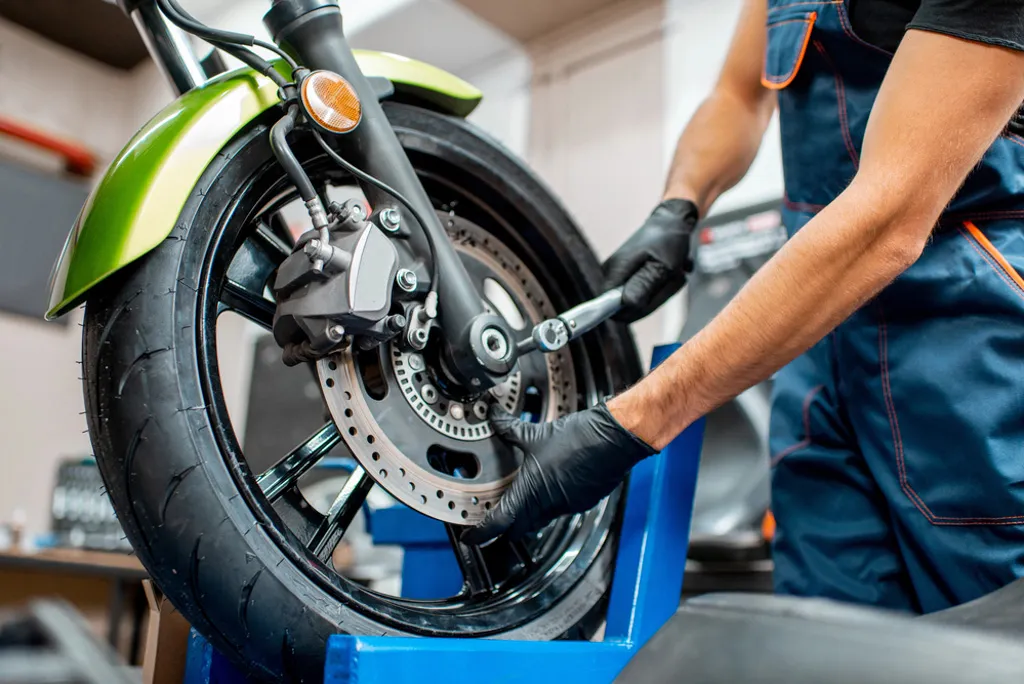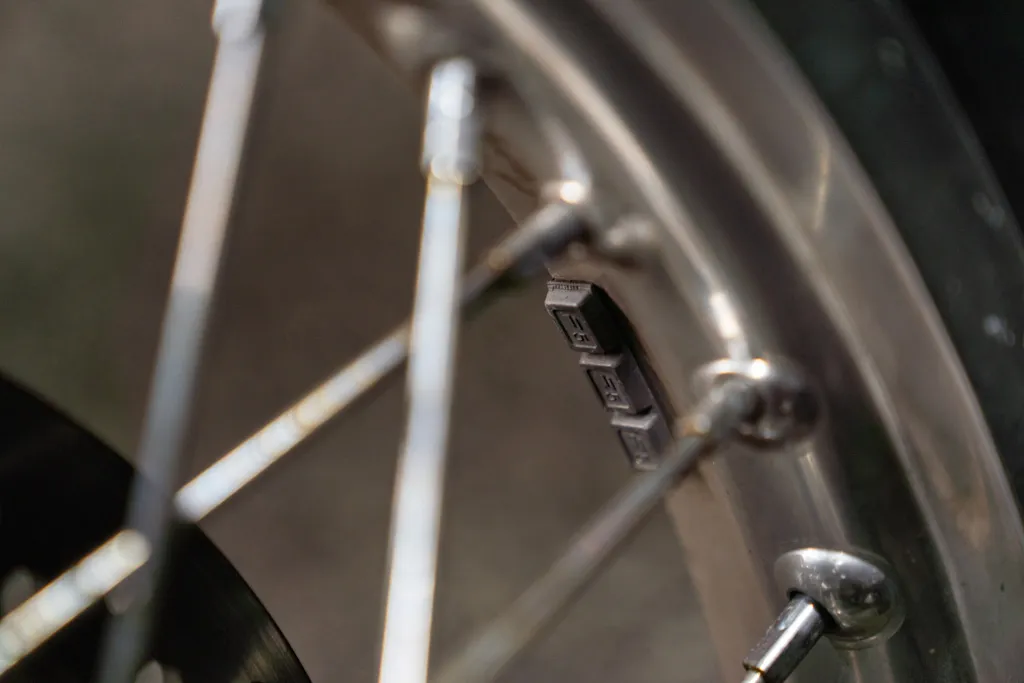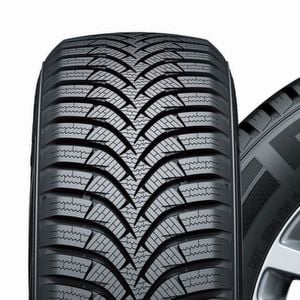Last Updated on 28.08.2024 by hrushetskyy

Driving a motorcycle is a thrill and a joy, but it can be less exhilarating if your tire is out of balance. Regular motorcycle maintenance is essential for enjoyable and safe riding, so read on to learn all about balancing motorcycle tires.
Do you have to balance a motorcycle tire?

Motorcycle tires should be kept balanced at all times to keep drivers safe. Unbalanced wheels will affect the motorcycle’s performance and can even lead to an accident. Keeping your motorcycle tires balanced will also help them to last longer. Unbalanced tires can cause uneven tread wear and shorten their lifespan through excess wear and tear.
Signs you’ve got a tire out of balance

Motorcycle tires are the most vital components of your motorbike as they keep you safely on the road. That’s why you need to keep them properly balanced. A motorcycle only has two tires, and an out-of-balance set makes you more prone to accidents.
There are a few tell-tale signs that you’ve got unbalanced tires. With a car, you might notice it in the steering wheel, but on a motorcycle, you are likely to feel an unusual vibration, similar to driving on a bumpy road when tires are out of balance. You may also notice uneven tire wear and faster tread wear.
Here’s what you should do if you suspect you have unbalanced tires:
- Check if your motorcycle has been driven on harsh road conditions that might cause the tire to become unbalanced.
- Inspect the tires for signs of uneven tread wear.
- Take your motorcycle to a tire shop for tire balancing if you see any uneven wear.
Remember, you must check if you suspect you have unbalanced tires. Tires that are incorrectly balanced will damage your motorcycle and can lead to loss of control or an accident if left uncorrected.
Do you have to balance a motorcycle tire?
If you suspect unbalanced wheels on your motorcycle, you need to take it for a tune-up of your wheels. Tire balancing ensures that the weight is distributed evenly, as imbalance begins with uneven weight on the rim of the wheel or tire. Here are things you should check to tell if a motorcycle tire is out of balance:
- It’s easy to tell a possible tire imbalance. You will feel an unusual vibration when tires are out of balance at certain speeds. The vibrations are noticeable and can be felt throughout the motorcycle.
- Tires will also show uneven and faster tread wear, and out-of-balance tires may also show scalloped or cupped wear patterns.
A balanced tire will roll smoothly, ensuring you get the maximum lifespan from your new tires. Aside from comfort, balanced tires will make the trip safer for you.
Risks of an unbalanced motorcycle wheel
An unbalanced motorcycle tire spells danger. The misalignments and vibrations affect the wheel spindle and the wheel bearings, leading to premature wear. Too much vibration can also lead to loose fasteners and hotter tires, leading to uneven wear.
Causes of tires going out of balance
There are several reasons why you end up with unbalanced tires on your motorcycle.
Balanced tires have a uniform distribution of weight around the wheel and tire around the axle. However, every time you drive, the weight distribution shifts, and over time, these weight shifts add up, causing unbalanced tires.
Tires experience wear and tear through normal driving, as well as contact with uneven pavement, potholes, and rough roads. This wear and tear can also cause the tires to become unbalanced. Taking a sharp turn over a curb also puts stress on tires that might lead to imbalance.
If your motorcycle has been driven on rougher-than-usual road conditions, you might want to check it immediately for unusual wear and tear and get it rebalanced. A visual inspection should tell you if the motorcycle tires need replacing or just balancing.
Motorcycle tire balancing and maintenance tips

Motorcycle tires should be inspected before going on a ride and as part of your regular auto maintenance. Making sure you have balanced tires ensures your safety and that of any passengers. Here are some tips to keep your tires in good condition or if you suspect that your motorcycle tire is out of balance:
- Check the motorcycle tire’s pressure. Motorcycle owners should read their manual to check the recommended tire pressures. Tire pressures are also found on the bike’s swing arm.
- Avoid reducing the PSI (pounds per square inch) just so you can have a “softer ride.” Some motorcycle drivers like to do this. However, the load capacity of a motorcycle rests on the air pressure you put into the tires. Lowering the recommended PSI will compromise your tires and your safety.
- Run the tire pressures between one and two PSI above the recommended PSI. Under normal conditions, average tires lose one PSI every four weeks. Consider weather changes, too, as changes in temperature can affect the air pressure in your tires.
- Inspect the wear patterns of tires. Motorcycle tires that are out of balance often form patch-wear, a wear pattern that is random and is found in different spots around the tires. This is due to the vibration of the motorcycle tires that are out of balance.
- A difference of 1/16” in tread depth or more indicates the tires are uneven. When you see the tread wear in random flat spots, it might be caused by an imbalance in the tire.
If you want to know how to tell if motorcycle tires need replacing, check the tread wear. A tread depth gauge will tell you whether the tread of your tire is still road-worthy or if it’s time to replace it.
How to check motorcycle tire pressure
We have already mentioned the importance of keeping the proper tire pressure and how this could affect the balance of motorcycle tires. Follow these tips for checking tire pressure:
- First, check the tires when cold. Tires are cold when your motorcycle hasn’t been used for at least three hours or if you have driven it less than a mile at a moderate speed.
- Consult your motorcycle dealer if you cannot find your manufacturer’s recommended PSI. You may also consult a tire professional.
- Take note of the PSI for each tire. Avoid getting confused by writing down the required pressure levels for each tire.
- Use a tire pressure gauge to check the pressure. Place the pressure gauge on the valve stem and press down hard. Your gauge will give the reading. Write it down and check the other tire.
- Use the recommended PSI when refilling tires with low pressure. After refilling, use the gauge to check the pressure again. Avoid overinflation and underinflation.
- Check the tire pressure monthly.
Balancing tires
If you’ve decided your tires need balancing, the best idea is to take your motorcycle to a tire shop for balancing.
The unbalanced tires are placed on a tire-balancing machine to take measurements to identify the lighter or heavier areas and adjust them. The mechanic will spin the tire and take note of its vibration measurements. The mechanic then identifies where and how much weight to put on the tire, attempting to spread the weight evenly.
The mechanic will adjust the weight or move the tire on the wheel to rebalance it since there might be an alignment of a heavy spot on both the wheel and the tire. Balancing tires regularly, for example, every 4,000 to 6,000 miles during ordinary use, will help to keep your tires in top shape.
Static balancing of motorcycle wheels can also be carried out after tires have been fitted. When fitting a tire, technicians should check the integrity and runout of the disc. If the disc is found to be damaged or deformed, it’s essential to repair it before balancing takes place.
Once the tires are fitted, the wheel will be hung on a special stand to sit horizontally, with a freely rotating axis. From here, the wheels are balanced with inflated rubber and brake discs. If your rear wheel is rigidly attached to the disc, it may need to be balanced with a star (check your motorcycle manual to see if this is necessary).
The difference between tire balancing and wheel alignment
When it comes to tires, you have probably heard about alignment and balancing, which are different things. While wheel alignment is different for motorcycles than cars, both should be part of your regular motorcycle maintenance.
Your motorcycle needs both wheels on the same axis of symmetry so they travel in the same direction and make contact with the ground properly.
During wheel alignment, the technician will inspect the tire tread for any signs of poor alignment and check the wheel orientation. Most motorcycle manufacturers recommend getting a wheel alignment check-up every 10,000 miles. You should also carry out alignment after any work on your motorcycle’s wheels or tires, checking their position as stated in your user’s manual.
Different types of tire balancing
There are three types of tire balancing, two of which are carried out on motorcycles:
- Static – The uneven tires are placed on a verticle supporter with a spindle tool in static balancing. A bubble balancer can also be used. This involves adding weight across only one line or one tire plane. Static balancing is best for minor cases of unbalanced tires.
- Dynamic – In dynamic balancing, the tires are placed on a machine that spins them at certain speeds. The machine measures the weight and provides information on how much weight should be added. The spin balancer also shows the stiff spots in motorcycle tires when there is an imbalance.
Balancing motorcycle tires at home
It is possible to balance motorcycle tires by yourself in your garage if you are familiar with the mechanics of your motorcycle. However, you will need a static balancer, with a frame and a horizontal shaft, to place the wheel and rotate it. It is possible to build your own balancer and use your axle to get a perfect fit, or you can buy a factory-made balancer online for about $100.
Preparing for balancing
- If you have a static balancer, you must remove all the weights from your tires before balancing them. Make sure your balancer is placed on a stable surface, and the shaft is at the correct level.
- Remove the wheels from the motorcycle and prepare them for rebalancing by cleaning up the tires, rim, and other parts.
Static balancing: 7 steps
- Swing the wheel so that it stops with the heaviest point of the wheel at the bottom (point X1).
- Next, turn the wheel 90 degrees and release it, making sure that point X1 is in the same place. If it isn’t in the middle position, repeat this until it is.
- Place a small weight opposite point X1. We recommend starting with the smallest weights and attaching them loosely so they can be removed if necessary.
- Again, turn the wheel 90 degrees and release. If the weight you have attached goes to the top, point X1 is still heavier, and you need to add more weight opposite it. Keep adding weight until the wheel moves when turning 90 degrees.
- If your wheel does not move in various positions, you can take off the test weights and glue on new ones. Remember to fully degrease the surface area before gluing. We recommend putting the weights on the central edge of the disc or with spoked wheels on the spokes. We also suggest gluing the weights symmetrically on either side of the disc.
- At this point, if your wheel is not static in some positions, you may need to carry out the full balancing again from scratch. This could be an issue if the wheel isn’t rigidly fixed to the axis; your disc or rubber is deformed; the rubber is not installed coaxially with the valve; the bearings are severely worn; or, if the wheel is spoked, it may have a dynamic runout due to poorly stretched spokes.
- Finally, you can put your wheels back on your motorcycle.
Frequently Asked Questions
What happens if a tire is out of balance?
If a motorcycle tire is out of balance, you’ll probably notice vibration through the handlebars and the frame, especially at higher speeds. This can lead to uneven tire wear, reducing the lifespan of your tires. Additionally, it can affect your motorcycle’s overall handling and stability, making your ride less smooth and potentially less safe. To fix this, it’s best to have your tires balanced by a professional.
How do you fix unbalanced tires—do I have to use a tire shop?
Fixing unbalanced motorcycle tires is straightforward but requires the right tools and a bit of know-how. This is why most people choose to do it at a tire shop or with a mechanic. If you decide to balance the tires yourself, you’ll need a motorcycle wheel balancer, which you can find at most auto parts stores or online.
Start by removing the wheel from your bike and placing it on the balancer. Spin the wheel and let it come to a stop naturally; the heaviest part will settle at the bottom. Attach wheel weights to the opposite side of the heavy spot to balance the weight distribution. Keep adjusting and testing until the wheel spins evenly without favoring any side. Once balanced, reattach the wheel to your motorcycle. If you’re uncomfortable doing this yourself, a professional mechanic can balance it quickly and accurately.
How do I know if my motorcycle wheel is out of balance—will I see uneven tire wear?
Knowing if your motorcycle wheel is out of balance is all about paying attention to how your ride feels. The most telltale sign is a noticeable vibration in the handlebars, seat, or footpegs, especially at higher speeds. You might also feel a wobbling or shimmying sensation. Another clue is uneven tire wear, which can indicate that one part of the tire consistently makes more contact with the road than others. If you notice any of these symptoms, checking your tire balance is a good idea.
How do you balance motorcycle tires?
Motorcycle tires can be balanced at home with a motorcycle wheel balancer and some wheel weights. First, take the wheel off the bike and put it on the balancer. Give the wheel a gentle spin and let it come to a stop naturally; the heaviest part will settle at the bottom. Mark this spot and then attach wheel weights to the opposite side to counterbalance the weight. Continue doing this until the wheel spins smoothly without favoring any particular side. Most motorcycle shops offer balancing services if you’re unsure about doing this yourself.
Share the Knowledge
